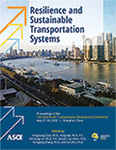13th Asia Pacific Transportation Development Conference
Study on Fire Impact and Personnel Evacuation of Metro Trains in the Rail-and-Road Integrated Yangtze River-Crossing Tunnel
Publication: Resilience and Sustainable Transportation Systems
ABSTRACT
The interval evacuation is an important problem faced by emergency management of metro operations, especially the tunnel evacuation in the river-crossing area. This paper takes the rail-and-road integrated Yangtze River-crossing tunnel in Wuhan as the background. The subway thermal environment simulation software SES is used to study the smoke control mode of the most unfavorable working conditions in the river-crossing tunnels. The FDS computer modeling is used to simulate the flow of smoke in typical working conditions. Combined with the emergency evacuation experience of the actual operation of Wuhan rail transit, the evacuation plan of the tunnel fan assisted smoke exhausting before and after the opening is obtained. It provides a reference for the emergency evacuation command and operation of the train after the fire broke out in the section of the long railway crossing.
Get full access to this article
View all available purchase options and get full access to this chapter.
REFERENCES
Bhzad, S. (2013). “Editorial: traffic safety: national partnership and corporate social responsibility.” Transportation Science and Technology 3(2), 39-42.
Chen, S. k., Di, Y., Shi, R. D., Jing, L., and Wang, B. (2017). “Simulation and Analysis on Impacts and Evacuation during the Process of Fire on Metro Platforms.” Journal of Transportation Systems Engineering, (1), 245-252.
Fan, H. M., Zhao, Y. H., and Zhang, D. (2010) “Study on multifunctional experiment platform of scale model of subway tunnel and station.” Journal of the China railway Society 32(5), 88-92.
Fan, C. G., Ji, J., and Sun, J. H. (2015) “Influence of longitudinal fire location on smoke characteristics under the tunnel ceiling.” Fire& Materials 39(1), 72-84.
Fan, C. G. and Yang, J. (2017) “Experimental study on thermal smoke backlayering length with an impinging flame under the tunnel ceiling.” Experimental Thermal & Fluid Science 82, 262-268.
Fan, C. G., Zhang, L., and Jiao, S. C. (2018) “Smoke spread characteristics inside a tunnel with natural ventilation under a strong environmental wind.” Tunneling and Underground Space Technology 82, 99-110.
Hu, Q. H. (2017) “Design of ventilation of Yangtze River-crossing highway-metro integrated tunnel on Sanyang Road in Wuhan.” Tunnel Construction 37(1), 62.
Kadlic, M., & Mózer, V. (2017) “Uncertainties associated with tunnel design fire Scenarios.” Procedia Engineering (192), 387-392.
“Ministry of Housing and Urban-Rural Construction of the People's Republic of China. (2017) GB 51251-2017 Technical Standard for Building Smoke Control and Exhaust System.” Chengdu: China Planning Press.
Peter, S., Michael, B., Mehdi, R. (2017) “On the problem of ventilation control in case of a tunnel fire event.” Case Studies in Fire Safety (7), 36-43.
Pengen, Z., Wei, W. Z., Jian, M., Tu, J. F., Ding, R., Pengen, Z., et al. (2017). “Numerical Simulation & Scene Experiment of Metro Tunnel with Crossover Interval under Fire Conditions.” Procedia Engineering, (205), 87-94.
Philip, J. D., Dougal, D., Craig, L. B., et al. (2002) SFPE Handbook of Fire Protection Engineering Third Edition. Massachusetts: National Fire Protection Association Quincy 2-258-2-268.
Wang, F., Wang, M. N. (2016). “A computational study on effects of fire location on smoke movement in a road tunnel.” Tunneling & Underground Space Technology (51), 405-413.
Zhong, W., Tu, R., Yang, J. P. (2015). “A study of the fire smoke propagation in subway station under the effect of piston wind.” Journal of Civil Engineering and Management 21(4), 514-523.
Zhao, B. (2018). “Design of Fire Linkage Control Scheme for Yangtze River-crossing Tunnel on Sanyang Road of Wuhan Metro.” Tunnel Construction 38(1), 121-128.
Xu, Z. S., Zhao, J. M., and Liu, Q. L. (2019) “Experimental investigation on smoke spread characteristics and smoke layer height in tunnels.” Fire and Materials 43(3), 1-7.
Information & Authors
Information
Published In
Resilience and Sustainable Transportation Systems
Pages: 337 - 345
Editors: Fengxiang Qiao, Ph.D., Texas Southern University, Yong Bai, Ph.D., Marquette University, Pei-Sung Lin, Ph.D., University of South Florida, Steven I Jy Chien, Ph.D., New Jersey Institute of Technology, Yongping Zhang, Ph.D., California State Polytechnic University, and Lin Zhu, Ph.D., Shanghai University of Engineering Science
ISBN (Online): 978-0-7844-8290-2
Copyright
© 2020 American Society of Civil Engineers.
History
Published online: Jun 29, 2020
Published in print: Jun 29, 2020
Authors
Metrics & Citations
Metrics
Citations
Download citation
If you have the appropriate software installed, you can download article citation data to the citation manager of your choice. Simply select your manager software from the list below and click Download.
